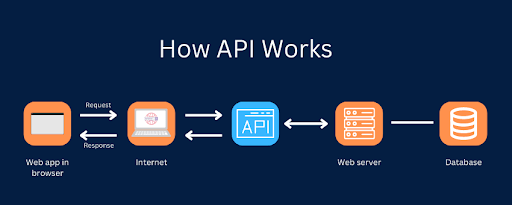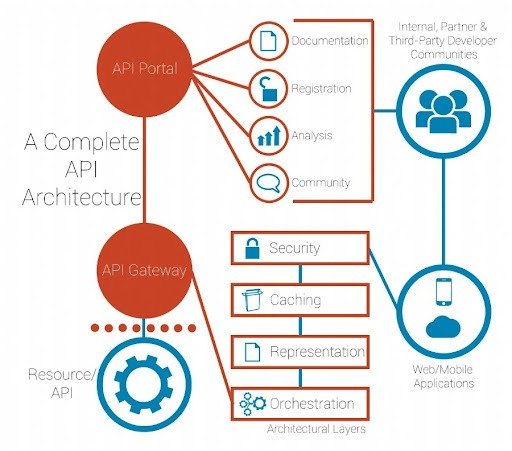Top 10 Open Source API Management Tools
When it comes to web applications and software development then APIs are the crucial part that exchange data between one software application or product and another. APIs are used widely in every sector.
Even in the hospitality and healthcare industry, APIs are playing crucial roles to provide a smoother experience to guests and establish a digital healthcare solution for patients. Now you can imagine the value of APIs whether it is E-commerce, Manufacturing, Banking, or the Travel industry APIs are majorly used for Application development.
Basically, API (Application programming interface) works as a messenger that takes requests from clients and returns responses from the database.

API mainly has four types of action, through these requests data can be fetched, add, modify and delete from the server –
- GET – To request any data from the server
- POST – To add new data or information to the server
- PUT – To edit or modify data on the server
- DELETE – To delete information or data from the server
Now you have enough knowledge about APIs. But API management is also an important thing that you should know before creating APIs.
What Is API Management?
The step-by-step procedure of managing API functions like API creation, publication, securing, and monitoring is called API MANAGEMENT.
API is best utilized when there is proper documentation, in-depth testing, regular versioning, high reliability, and increased security.
This is where the need for API Management tools comes into the picture!
By acting as an intermediate between your company and developers, API management tools assist in making the process of publishing and integrating APIs more structured.
They let you specify what the customers can access, set usage standards for each API, track analytics on who is using them the most frequently and in what ways, and set security protocols.
The features of API can be used to the fullest only when they work with the right management tools.
So, what are some common functions that API Management tools have?
- It protects API from getting misused
- It monitors traffic
- Memory Management
- It provides usage reporting
- Authentication and authorization
Top 10 API Management Tools:
1. AKANA
Akana is one of the most widely used API Management Tools which helps in boosting outreach across various digital platforms, looks over analytics for data optimization, and pushes partner endorsements.
One of the distinct features of Akana is that it allows fellow users to secure their APIs while providing access to authorized users and applications.
Features:
- Provide open-source support
- Lifecycle management
- Traffic management
- Detect vulnerabilities during run-time
- Developer portal
2. 3SCALE
3Scale is a multi-featured API Management tool that assists in providing accessibility, scalability, and flexibility which allows you to manage API on grounds of infrastructure.
The main reason for its popularity is its ability to provide crystal clear and logical solutions for the respective company. It caters to performance and consumer control.
Features:
- It has multiple traffic controlling ways such as plugins, hosted cloud services, open-source gateway, etc.
- It has various features like access control, security dashboard, rate limits, analytics, etc.
3. APIGEE
Apigee is an API development and management tool/platform. It provides an abstraction for your backend service APIs and provides security, rate restriction, quotas, analytics, and more by fronting services with a proxy layer.
Some of the features are listed below:
- Connecting historical data repositories to a modern user interface.
- Automate the creation of API documentation and software development kits.
- Supporting multi-cloud and hybrid cloud deployments.
- Generating actionable insights, it uses machine learning and analytics.
- Providing API troubleshooting, security, and optimization of monitoring tools.
- Scalable
4. SWAGGERHUB
SwaggerHub is one of a kind API design and documentation tool which is created to help teams maintain uniformity and discipline throughout the API development process.
It is faster and more standardized.
The design process of your team can be accelerated without sacrificing quality or organizational style.
SwaggerHub gives the ability to create stunning documentation. It’s interactive, fully hosted, and privacy-protected, removing the need for manual infrastructure complexity.
The following are the most important Swagger tools:
Swagger Editor: It’s a browser-based editor that is used to write OpenAPI specifications.
Swagger UI: creates interactive API from OpenAPI standards.
Swagger Codegen: from an OpenAPI spec, it generates server stubs and client libraries.
5. DELL BOOMI
Dell Boomi AtomSphere is a cross-functional cloud integration platform for linking cloud and on-premises applications and data that is available on demand. The customers use the platform to create cloud-based integration processes known as Atoms, as well as transfer data between cloud and on-premises applications. Each Atom is designed to specify what is required for integration.
Some major benefits of Dell Boomi are:
- Advanced Research and Development:
Dell Boomi enables developers to design a vibrant set of apps, including both simple and complicated solutions.
- Scalability:
When a company uses multiple applications, scalability is a key challenge. Dell Boomi is a comprehensive platform that ensures scalability and productivity.
- Reduced Development Time:
It requires minimal to no code because it makes use of pre-built integration components. To construct integrations, users can use the ‘drag and drop’ mapping tool to add recyclable components.
Dell Boomi integrations can be developed without coding, saving both time and resources.
6. MULESOFT
It is one of the leading API tools that help enterprises in making their businesses digitized by connecting all of their business systems, including apps, data, devices, and more.
- The tool improves agility with a flexible and developing architecture that adapts to your business’s individual needs.
- Helps in enhancing productivity and reduces development time.
- Providing an amazing user experience helps in making happy customers and gaining a competitive edge over others.
7. WORKATO
It blends an enterprise-grade workflow automation platform with the ease of use found in consumer apps, allowing both business and IT users to create workflow automation fast.
Workato features a robust feature set for dealing with real-world issues, like the integration of apps, data, and people. On-premises and cloud-based systems are both supported.
It enables thorough implementation and enforcement of policies to improve security and governance across all Workato users within an enterprise.
8. Software AG
WebMethods from Software AG allows you to instantly connect with systems, partners, data, devices, and other SaaS applications. Agile applications, API administration, business process management, integration, and operational intelligence are all covered and managed by webMethods products.
With the help of Software AG, multiple organizations can share a single development execution environment while maintaining their separate production environments with a completely multi-tenant architecture. Users of the webMethods Integration Server can simply connect to this cloud integration solution to construct dependable and safe cloud-to-on-premises integrations.
Software AG resolves the problems and provides solutions for application integration, SAP integration, and more, in addition to cloud integration.
9. AZURE
Azure API Management is a multi-cloud management tool for APIs.
Azure API management assists customers in overcoming the following challenges:
- API users should be able to ignore the diversity and complexity of backend infrastructure.
- Securely provide APIs for services hosted both inside and outside of Azure.
- APIs must be protected, accelerated, and monitored.
- Allow internal and external users to discover and consume APIs.
10. POSTMAN
Postman is an API platform that assists you in creating and using APIs. It improves collaboration and simplifies each phase of the API lifecycle by allowing us to design better APIs faster.
- It assists in the safe automation and integration of manual tests, ensuring that no code is broken.
- It allows you to mock and design API responses without needing to set up a backend server.
- The documentation can be read by machines.
- It helps to check API performance and response times on a regular basis.
Conclusion
We have seen the top 10 open-source API management free and paid tools. These API Management tools serve the purpose of providing long and short-term solutions for the organization.
It is important to choose the ideal tool that caters to your demands.






